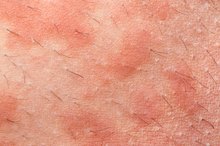Small Red Bumps on the Wrist
Small red bumps that appear on your wrist may resemble a cluster of raised bumps or a bumpy rash that seems to be connected. Depending upon the cause of the bumps, it may spread to other parts of your body as well. You may also find that many causes of the bumps lead them to grow in size and make large patches that are red and swollen.
Causes
Bedbugs are a common cause of red bumps appearing on your body, including the wrists and hands. They are most commonly found in mattresses and box springs that have been infested as well as in the seams of upholstered furniture and underneath loose wallpaper, according to The Mayo Clinic 1. Contact dermatitis is another potential cause of these bumps. This condition is brought on by an allergic reaction to any number of substances, including the detergents you use to wash clothes, various types of topical ointments and ingredients found in perfumes or colognes. According to Medline Plus, eczema may also cause red bumps to appear on your body 3. Eczema is not contagious or dangerous, although it can occur at the most inconvenient times.
Identification
The Signs and Symptoms of Flea Bite Allergies in Humans
Learn More
The Mayo Clinic states the bedbug bites appear as a cluster of red bumps that have a darker red bump in the center 1. These bumps not only appear on the wrist, but can also be found on the hands, neck and face. Contact dermatitis usually appears within hours of coming into contact with an item or substance that you are allergic to. Depending upon the allergen, they may initially appear as bumpy, red skin and develop into blisters if the reaction is severe enough. Eczema is most commonly identified by skin that is red, swollen and flaky.
- The Mayo Clinic states the bedbug bites appear as a cluster of red bumps that have a darker red bump in the center 1.
- Depending upon the allergen, they may initially appear as bumpy, red skin and develop into blisters if the reaction is severe enough.
Effects
The American Academy of Dermatology describes contact dermatitis as itchy bumps that may sting and burn when touched 2. In serious cases, the blisters may fill with pus and erupt, causing a painful open wound. Eczema causes the skin in the affected area to become dry and extremely itchy. Bedbugs may cause absolutely no reaction for some people while others may break into hives and blisters that are severely itchy, according to the Mayo Clinic 1.
Warning
What Is the Difference Between Cellulitis & Mrsa?
Learn More
Eczema is a condition that, while it is not curable, it is also not dangerous. If you are diagnosed with eczema, your doctor will prescribe an appropriate treatment plan for you. If you have contact dermatitis and experience a severe reaction that includes hives and blisters, medical attention should be immediately sought. Those with bedbugs who have a serious skin reaction should also see their doctor.
- Eczema is a condition that, while it is not curable, it is also not dangerous.
- If you are diagnosed with eczema, your doctor will prescribe an appropriate treatment plan for you.
Prevention/Solution
Bedbugs are typically treated with either an oral antihistamine or a topical hydrocortisone cream. To prevent repeat occurrences of bedbugs, inspect any upholstered furniture or mattresses and wear pajamas to bed as bedbugs are not known to get under clothing. Contact dermatitis is treated with topical moisturizers, oral antihistamine or a calcineurin inhibitor. Antibiotics are also used if an infection develops. Eczema outbreaks can be avoided by eliminating yourself from stressful situations and staying away from irritants. A topical lotion or hydrocortisone cream is commonly used to treat outbreaks.
- Bedbugs are typically treated with either an oral antihistamine or a topical hydrocortisone cream.
- Contact dermatitis is treated with topical moisturizers, oral antihistamine or a calcineurin inhibitor.
Related Articles
References
- Mayo Clinic: Bedbugs
- American Academy of Dermatology: Contact Dermatitis
- Medline Plus: Eczema
- Ennis AC, Pearson-Shaver AL. Bedbug bites. [Updated 2020 Feb 23]. In: StatPearls [Internet]. Treasure Island (FL): StatPearls Publishing; 2020 Jan-.
- Doggett SL, Dwyer DE, Peñas PF, Russell RC. Bed bugs: clinical relevance and control options. Clinical Microbiology Reviews. 2012;25(1):164-192. doi:10.1128/CMR.05015-11
- Studdiford JS, Conniff KM, Trayes KP, Tully AS. Bedbug infestation. American Family Physician. 2012 Oct 1;86(7):653-658.
- Cimolai N, Cimolai TL. Otitis from the common bedbug. J Clin Aesthet Dermatol. 2012;5(12):43‐45.
- Delaunay P. Human travel and traveling bedbugs. J Travel Med. 2012;19(6):373‐379. doi:10.1111/j.1708-8305.2012.00653.x
- Goddard J, deShazo R. Bed Bugs (Cimex lectularius) and Clinical Consequences of Their Bites. JAMA. 2009;301(13):1358-1366. doi:10.1001/jama.2009.405
- Centers for Disease Control and Prevention. Bed bugs FAQs. Updated January 4, 2017.
- American Academy of Dermatology. Bed bugs: Diagnosis and treatment.
- Goddard J, de Shazo R. Psychological effects of bed bug attacks (Cimex lectularius L.). Am J Med. 2012;125(1):101‐103. doi:10.1016/j.amjmed.2011.08.010
- United States Environmental Protection Agency. Do-it-yourself bed bug control.
- University of Minnesota Extension. Prevention and control of bed bugs in homes.
Writer Bio
Kristin Davis has been writing since 2004, specializing in the health and fitness fields. She has written for online and print publications including Fitness Monthly and Creative Circle. Davis has certification through the International Fitness Professionals Association as a personal trainer.








